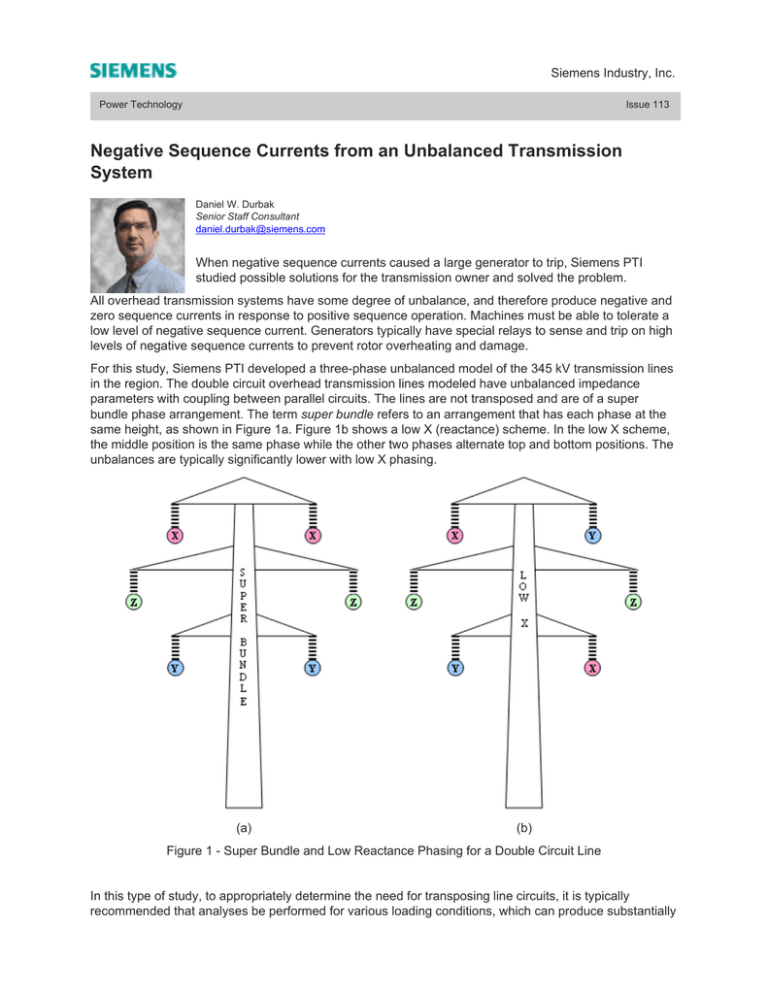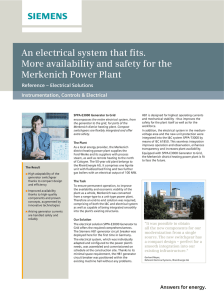Negative Sequence Currents from an Unbalanced
advertisement

Siemens Industry, Inc. Power Technology Issue 113 Negative Sequence Currents from an Unbalanced Transmission System Daniel W. Durbak Senior Staff Consultant daniel.durbak@siemens.com When negative sequence currents caused a large generator to trip, Siemens PTI studied possible solutions for the transmission owner and solved the problem. All overhead transmission systems have some degree of unbalance, and therefore produce negative and zero sequence currents in response to positive sequence operation. Machines must be able to tolerate a low level of negative sequence current. Generators typically have special relays to sense and trip on high levels of negative sequence currents to prevent rotor overheating and damage. For this study, Siemens PTI developed a three-phase unbalanced model of the 345 kV transmission lines in the region. The double circuit overhead transmission lines modeled have unbalanced impedance parameters with coupling between parallel circuits. The lines are not transposed and are of a super bundle phase arrangement. The term super bundle refers to an arrangement that has each phase at the same height, as shown in Figure 1a. Figure 1b shows a low X (reactance) scheme. In the low X scheme, the middle position is the same phase while the other two phases alternate top and bottom positions. The unbalances are typically significantly lower with low X phasing. (a) (b) Figure 1 - Super Bundle and Low Reactance Phasing for a Double Circuit Line In this type of study, to appropriately determine the need for transposing line circuits, it is typically recommended that analyses be performed for various loading conditions, which can produce substantially Power Technology March 2012 different results. It may also be important to simulate various operational conditions of parallel circuits (for instance, all circuits in simultaneous operation or only some of them in operation). For this study, various operational conditions were simulated, as were medium, heavy and capacity power conditions. The generator in question had experienced tripping due to negative sequence currents during heavy load. The results verified that unequal phase impedances of the transmission line produced the current unbalances for steady state power flow. The study assessed the magnitude of negative sequence voltages and currents in the generator for various system loading conditions. Siemens PTI developed and tested a set of solutions that have the greatest potential to mitigate the 345 kV unbalances in the vicinity of the generator. Each solution case was tested with the three base case load flows. The following conclusions were made based upon the simulated results: The generator can draw high levels of negative sequence currents from the unbalanced 345 kV transmission system. The negative sequence currents are driven by the negative sequence voltage at the 345 kV bus. The negative sequence currents in the generator are independent of the positive sequence load of the generator. The negative sequence voltage at the 345 kV bus increases with the load on the lines. The Siemens PTI recommendation was to alter the phase position of one particular double-circuit 345 kV line. The transmission owners made the Siemens PTI-recommended alteration, which reduced the negative sequence currents in the generator to tolerable levels, and the problem was solved. Page 2

